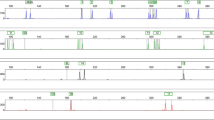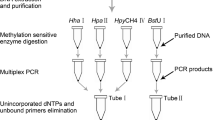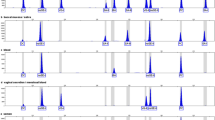Abstract
Blood-containing mixtures often appear in murder and robbery cases, and their identification plays a significant role in solving crimes. In recent years, the co-detection of DNA methylation markers (CpG) and single nucleotide polymorphism (SNP) markers has been shown to be a promising tool for the identification of semen and its donor. However, similar research on blood stains that are frequently found at crime scenes has not yet been reported. In this study, we employed blood-specific CpG-linked SNP markers (CpG-SNP) for blood-specific genotyping and the linking of blood and its donor. The tissue-specific CpG markers were screened from the literature and further verified by combining bisulfite conversion with amplification-refractory mutation system (ARMS) technology. Meanwhile, adjacent SNP markers with a minor allele frequency (MAF) greater than 0.1 were selected within 400 bp upstream and downstream of the CpG markers. SNP genotyping was performed using SNaPshot technology on a capillary electrophoresis (CE) platform. Finally, a multiplex panel, including 19 blood-specific CpG linked to 23 SNP markers, as well as 1 semen-specific CpG, 1 vaginal secretion-specific CpG, and 1 saliva-specific CpG marker, was constructed successfully. The panel showed good tissue specificity and blood stains stored at room temperature for up to nine months and moderately degraded (4 < DI < 10) could be effectively identified. Moreover, it could also be detected when blood content in the mixed stains was as low as 1%. In addition, 15 ng of DNA used for bisulfite conversion was required for obtaining a complete profile. The cumulative discrimination power of the panel among the Han population of northern China could reach 0.999983. This is the first investigation conducted for the simultaneous identification of blood and its donor regardless of other body fluids included in mixed stains. The successful construction of the panel will play a vital role in the comprehensive analysis of blood-containing mixtures in forensic practice.






Similar content being viewed by others
Data availability
All data generated or analyzed during this study are included in this published article and its supplementary materials.
References
Virkler K, Lednev IK (2009) Analysis of body fluids for forensic purposes: from laboratory testing to non-destructive rapid confirmatory identification at a crime scene. Forensic Sci Int 188(1-3):1–17. https://doi.org/10.1016/j.forsciint.2009.02.013
Zhang X, Li J, Liu J, Wang J, Liu Z, Liu Y, Zhang G (2022) Identification of the vaginal secretion donor in mixture stains using polymorphic cSNPs on mRNA biomarkers. Forensic Sci Int Genet 59:102703. https://doi.org/10.1016/j.fsigen.2022.102703
Liu Z, Gao Z, Wang J, Shi J, Liu J, Chen D, Li W, Guo J, Cheng X, Hao T, Li Z, Li Y, Yan J, Zhang G (2020) A method of identifying the blood contributor in mixture stains through detecting blood-specific mRNA polymorphism. Electrophoresis 41(15):1364–1373. https://doi.org/10.1002/elps.202000053
Juusola J, Ballantyne J (2003) Messenger RNA profiling: a prototype method to supplant conventional methods for body fluid identification. Forensic Sci Int 135(2):85–96. https://doi.org/10.1016/s0379-0738(03)00197-x
Frumkin D, Wasserstrom A, Budowle B, Davidson A (2011) DNA methylation-based forensic tissue identification. Forensic Sci Int Genet 5(5):517–524. https://doi.org/10.1016/j.fsigen.2010.12.001
Lee HY, Park MJ, Choi A, An JH, Yang WI, Shin KJ (2012) Potential forensic application of DNA methylation profiling to body fluid identification. Int J Legal Med 126(1):55–62. https://doi.org/10.1007/s00414-011-0569-2
Park JL, Kwon OH, Kim JH, Yoo HS, Lee HC, Woo KM, Kim SY, Lee SH, Kim YS (2014) Identification of body fluid-specific DNA methylation markers for use in forensic science. Forensic Sci Int Genet 13:147–153. https://doi.org/10.1016/j.fsigen.2014.07.011
Moore LD, Le T, Fan G (2013) DNA methylation and its basic function. Neuropsychopharmacology 38(1):23–38. https://doi.org/10.1038/npp.2012.112
An JH, Choi A, Shin KJ, Yang WI, Lee HY (2013) DNA methylation-specific multiplex assays for body fluid identification. Int J Legal Med 127(1):35–43. https://doi.org/10.1007/s00414-012-0719-1
Madi T, Balamurugan K, Bombardi R, Duncan G, McCord B (2012) The determination of tissue-specific DNA methylation patterns in forensic biofluids using bisulfite modification and pyrosequencing. Electrophoresis 33(12):1736–1745. https://doi.org/10.1002/elps.201100711
Wasserstrom A, Frumkin D, Davidson A, Shpitzen M, Herman Y, Gafny R (2013) Demonstration of DSI-semen—a novel DNA methylation-based forensic semen identification assay. Forensic Sci Int Genet 7(1):136–142. https://doi.org/10.1016/j.fsigen.2012.08.009
Choi A, Shin K-J, Yang WI, Lee HY (2013) Body fluid identification by integrated analysis of DNA methylation and body fluid-specific microbial DNA. Int J Legal Med 128(1):33–41. https://doi.org/10.1007/s00414-013-0918-4
Antunes J, Silva DS, Balamurugan K, Duncan G, Alho CS, McCord B (2016) High-resolution melt analysis of DNA methylation to discriminate semen in biological stains. Anal Biochem 494:40–45. https://doi.org/10.1016/j.ab.2015.10.002
Ghai M, Naidoo N, Evans DL, Kader F (2020) Identification of novel semen and saliva specific methylation markers and its potential application in forensic analysis. Forensic Sci Int Genet 49:102392. https://doi.org/10.1016/j.fsigen.2020.102392
Lin YC, Tsai LC, Lee JC, Su CW, Tzen JT, Linacre A, Hsieh HM (2016) Novel identification of biofluids using a multiplex methylation sensitive restriction enzyme-PCR system. Forensic Sci Int Genet 25:157–165. https://doi.org/10.1016/j.fsigen.2016.08.011
Silva D, Antunes J, Balamurugan K, Duncan G, Alho CS, McCord B (2016) Developmental validation studies of epigenetic DNA methylation markers for the detection of blood, semen and saliva samples. Forensic Sci Int Genet 23:55–63. https://doi.org/10.1016/j.fsigen.2016.01.017
Vidaki A, Giangasparo F, Syndercombe Court D (2016) Discovery of potential DNA methylation markers for forensic tissue identification using bisulphite pyrosequencing. Electrophoresis 37(21):2767–2779. https://doi.org/10.1002/elps.201600261
Watanabe K, Akutsu T, Takamura A, Sakurada K (2016) Evaluation of a blood-specific DNA methylated region and trial for allele-specific blood identification from mixed body fluid DNA. Leg Med (Tokyo) 22:49–53. https://doi.org/10.1016/j.legalmed.2016.08.004
Watanabe K, Taniguchi K, Akutsu T (2018) Development of a DNA methylation-based semen-specific SNP typing method: a new approach for genotyping from a mixture of body fluids. Forensic Sci Int Genet 37:227–234. https://doi.org/10.1016/j.fsigen.2018.09.004
Watanabe K, Taniguchi K, Toyomane K, Akutsu T (2022) A new approach for forensic analysis of saliva-containing body fluid mixtures based on SNPs and methylation patterns of nearby CpGs. Forensic Sci Int Genet 56:102624. https://doi.org/10.1016/j.fsigen.2021.102624
Xie B, Song F, Wang S, Zhang K, Li Y, Luo H (2020) Exploring a multiplex DNA methylation-based SNP typing method for body fluids identification: as a preliminary report. Forensic Sci Int 313:110329. https://doi.org/10.1016/j.forsciint.2020.110329
Boyd VL, Zon G (2004) Bisulfite conversion of genomic DNA for methylation analysis: protocol simplification with higher recovery applicable to limited samples and increased throughput. Anal Biochem 326(2):278–280. https://doi.org/10.1016/j.ab.2003.11.020
Li Z, Li Y, Liu N, Yuan F, Liu F, Liu J, Yun K, Yan J, Zhang G (2022) Typing of semen-containing mixtures using ARMS-based semen-specific CpG-InDel/STR markers. Int J Legal Med 136(4):1163–1176. https://doi.org/10.1007/s00414-022-02843-9
Kaminsky Z, Petronis A (2009) Methylation SNaPshot: a method for the quantification of site-specific DNA methylation levels. In: Tost J (ed) DNA Methylation: Methods and Protocols. Humana Press, Totowa, NJ, pp 241–255
Jung SE, Cho S, Antunes J, Gomes I, Uchimoto ML, Oh YN, Di Giacomo L, Schneider PM, Park MS, van der Meer D, Williams G, McCord B, Ahn HJ, Choi DH, Lee YH, Lee SD, Lee HY (2016) A collaborative exercise on DNA methylation based body fluid typing. Electrophoresis 37(21):2759–2766. https://doi.org/10.1002/elps.201600256
Lee HY, An JH, Jung SE, Oh YN, Lee EY, Choi A, Yang WI, Shin KJ (2015) Genome-wide methylation profiling and a multiplex construction for the identification of body fluids using epigenetic markers. Forensic Sci Int Genet 17:17–24. https://doi.org/10.1016/j.fsigen.2015.03.002
Mehta B, Daniel R, Phillips C, McNevin D (2017) Forensically relevant SNaPshot((R)) assays for human DNA SNP analysis: a review. Int J Legal Med 131(1):21–37. https://doi.org/10.1007/s00414-016-1490-5
Lin YC, Tsai LC, Lee JC, Liu KL, Tzen JT, Linacre A, Hsieh HM (2016) Novel identification of biofluids using a multiplex methylation-specific PCR combined with single-base extension system. Forensic Sci Med Pathol 12(2):128–138. https://doi.org/10.1007/s12024-016-9763-3
Little S (1995) Amplification-Refractory Mutation System (ARMS) Analysis of point mutations. Curr Protoc Hum Genet 7(1):9.8.1–9.8.12. https://doi.org/10.1002/0471142905.hg0908s07
Ye S, Dhillon S, Ke X, Collins AR, Day INM (2001) An efficient procedure for genotyping single nucleotide polymorphisms. Nucleic Acids Res 29(17):e88–e88. https://doi.org/10.1093/nar/29.17.e88
Vernarecci S, Ottaviani E, Agostino A, Mei E, Calandro L, Montagna P (2015) Quantifiler ® Trio Kit and forensic samples management: a matter of degradation. Forensic Sci Int Genet 16:77–85. https://doi.org/10.1016/j.fsigen.2014.12.005
Shi YY, He L (2005) SHEsis, a powerful software platform for analyses of linkage disequilibrium, haplotype construction, and genetic association at polymorphism loci. Cell Res 15(2):97–98. https://doi.org/10.1038/sj.cr.7290272
Lewontin RC (1988) On measures of gametic disequilibrium. Genetics 120(3):849–852. https://doi.org/10.1093/genetics/120.3.849
Li Z, Li J, Li Y, Liu N, Liu F, Ren J, Yun K, Yan J, Zhang G (2021) Development of a multiplex methylation-sensitive restriction enzyme-based SNP typing system for deconvolution of semen-containing mixtures. Int J Legal Med 135(4):1281–1294. https://doi.org/10.1007/s00414-021-02552-9
Tian H, Bai P, Tan Y, Li Z, Peng D, Xiao X, Zhao H, Zhou Y, Liang W, Zhang L (2020) A new method to detect methylation profiles for forensic body fluid identification combining ARMS-PCR technique and random forest model. Forensic Sci Int Genet 49:102371. https://doi.org/10.1016/j.fsigen.2020.102371
Ballantyne KN, van Oorschot RA, Mitchell RJ (2011) Increased amplification success from forensic samples with locked nucleic acids. Forensic Sci Int Genet 5(4):276–280. https://doi.org/10.1016/j.fsigen.2010.04.001
Hayatsu H (2008) Discovery of bisulfite-mediated cytosine conversion to uracil, the key reaction for DNA methylation analysis--a personal account. Proc Jpn Acad Ser B Phys Biol Sci 84(8):321–330. https://doi.org/10.2183/pjab.84.321
Grunau C, Clark SJ, Rosenthal A (2001) Bisulfite genomic sequencing: systematic investigation of critical experimental parameters. Nucleic Acids Res 29(13):e65–e65. https://doi.org/10.1093/nar/29.13.e65
Tanaka K, Okamoto A (2007) Degradation of DNA by bisulfite treatment. Bioorg Med Chem Lett 17(7):1912–1915. https://doi.org/10.1016/j.bmcl.2007.01.040
Hong SR, Shin KJ (2021) Bisulfite-converted DNA quantity evaluation: a multiplex quantitative real-time PCR system for evaluation of bisulfite conversion. Front Genet 12:618955. https://doi.org/10.3389/fgene.2021.618955
Leontiou CA, Hadjidaniel MD, Mina P, Antoniou P, Ioannides M, Patsalis PC (2015) Bisulfite conversion of DNA: performance comparison of different kits and methylation quantitation of epigenetic biomarkers that have the potential to be used in non-invasive prenatal testing. PLoS One 10(8):e0135058. https://doi.org/10.1371/journal.pone.0135058
Liu Y, Siejka-Zielinska P, Velikova G, Bi Y, Yuan F, Tomkova M, Bai C, Chen L, Schuster-Bockler B, Song CX (2019) Bisulfite-free direct detection of 5-methylcytosine and 5-hydroxymethylcytosine at base resolution. Nat Biotechnol 37(4):424–429. https://doi.org/10.1038/s41587-019-0041-2
Wang J, McCord B (2011) The application of magnetic bead hybridization for the recovery and STR amplification of degraded and inhibited forensic DNA. Electrophoresis 32(13):1631–1638. https://doi.org/10.1002/elps.201000694
Funding
This work was supported by the Basic Research Program of Shanxi Province [No. 20210302123313] and the National Natural Science Foundation of China [No. 81701868, No. 82171876 and No. 82030058].
Author information
Authors and Affiliations
Contributions
The authors, Gengqian Zhang and Zeqin Li, were responsible for experimental conception and design. Zeqin Li, Na Liu, Fang Yuan, and Zimeng Guan carried out experimental preparation, operation, and data processing. The first draft of the manuscript was written by Zeqin Li and Na Liu. Zimeng Guan, Jinding Liu, Feng Liu, and Jianbo Ren gave valuable opinions and suggestions on the writing and revision of the manuscript. The authors Gengqian Zhang and Jiangwei Yan revised it critically for important intellectual content. All authors approved the final manuscript.
Corresponding authors
Ethics declarations
Ethics approval
Approval was obtained from the ethics committee of Shanxi Medical University (No. 2021GLL052). The procedures used in this study adhere to the tenets of the Declaration of Helsinki.
Consent to participate
Informed consent was obtained from all individual participants included in the study.
Consent for publication
The authors affirm that human research participants provided informed consent for the publication of the data in Supplementary Table S7.
Conflict of interest
The authors declare no competing interests.
Additional information
Publisher’s note
Springer Nature remains neutral with regard to jurisdictional claims in published maps and institutional affiliations.
Rights and permissions
Springer Nature or its licensor (e.g. a society or other partner) holds exclusive rights to this article under a publishing agreement with the author(s) or other rightsholder(s); author self-archiving of the accepted manuscript version of this article is solely governed by the terms of such publishing agreement and applicable law.
About this article
Cite this article
Li, Z., Liu, N., Yuan, F. et al. Development of a novel panel for blood identification based on blood-specific CpG-linked SNP markers. Int J Legal Med 138, 1205–1219 (2024). https://doi.org/10.1007/s00414-023-03105-y
Received:
Accepted:
Published:
Issue Date:
DOI: https://doi.org/10.1007/s00414-023-03105-y




